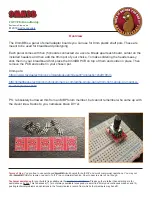
- 3/8 -
▲
▲
▲
▲
OPERATION
OPERATION
OPERATION
OPERATION
It is helpful to review operation before commencing operation. Steps (1) and (3) may be omitted
once you have verified that the unit is operating properly.
① Connect a 50-Ohm dummy load (not supplied) to the
“
M
”
(
“
UHF
”
) jack.
② Press the POWER switch to turn the unit on in the Normal mode.
Normal Mode Display Screen
Battery Level Meter (※2,3)
周波数表示
電池残量
Band Scale
The amateur bands 1.8-430 MHz are shown with a blue
band
band (※1).
Red underscore shows current band.
SWR Scale and Bar
The SWR is displayed graphically and numerically
Here. The SWR is shown to two decimal places.
OHMS Scale and Bar
The resistive component of the impedance is shown both
on the bar graph and numerically. Impedance (R, X) is
also displayed numerically.
※1 Note that not all the annotated amateur radio bands are available in all countries.
※2. If using Nickel-Metal Hydride batteries, the battery status meter will never show
“
Full.
”
You should recharge
the batteries once the Yellow indication appears. If using alkaline cells, replace when the Yellow indicator appears.
③ When connected to a 50-Ohm dummy load, the SWR indication should be 1.1 or less. If so, the meter
is performing correctly.
④ Perform measurements according to the discussion below.
▼
S
S
S
SW
W
W
WR Measurement
R Measurement
R Measurement
R Measurement
●Connect the coaxial cable to the meter; use the shortest possible cable between the antenna and
meter, as any cable between the antenna and meter can transform the measured impedance, and feedline
loss can also cause the displayed SWR to be better than it actually is. See FAQ later.
●
Set the BAND and FREQ knobs to the band and frequency to be tested on the antenna.
●
You may now read the SWR and resistive value of impedance (OHMS) on the display. If there is
a subtle difference between the mechanical and the LCD, the precision of the mechanical meter
has priority.
About the Reactance Display
About the Reactance Display
About the Reactance Display
About the Reactance Display
The display of impedance on the LCD includes both resistive (R) and reactance (X) indications.
Note that the X display is absolute value, so the polarity (+ or -) cannot be viewed.
▼
Measurement of Antenna Resonant Frequency
Measurement of Antenna Resonant Frequency
Measurement of Antenna Resonant Frequency
Measurement of Antenna Resonant Frequency
■Connect the antenna to the appropriate antenna connector on the meter, using the shortest possible
cable. If you use a long cable, the measurement will also include the effects of feedline loss, and
impedance differences between the antenna system and coaxial cable will not show the actual antenna
impedance.
■While watching the frequency display, rotate the FREQ knob while observing SWR. If you rotate the
FREQ knob to the point where the frequency no longer changes, change the Band to set a new range.
■
The frequency at which the minimum SWR is observed is the resonant frequency for the system.
Incidentally. . .
Because of stray inductance and capacitance, it is possible for the meter to show a
“
quasi
”
resonant
frequency. If the measured
“
resonant
”
frequency is different from what you expected, inspect your
system for these possible issues, in addition to those mentioned previously.
Full charge
Nearly full
Battery low
Battery level
Critically low
All manuals and user guides at all-guides.com


























